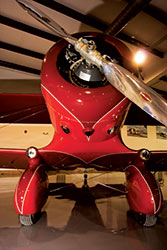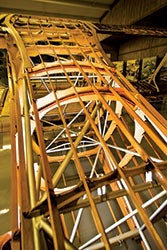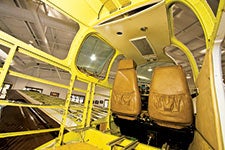 A flight of three Staggerwings has just made a low pass along the runway; eight V-tail Bonanzas in two echelons are flying overhead at 1,000 feet AGL; and a Model 18 Twin Beech and a Twin Bonanza in formation swoop out of the sky and thunder by. More vintage Beechcraft in twos, threes and fours are making circuits and performing flybys for the crowd of several hundred gathered here at Tullahoma Regional Airport (KTHA) in eastern Tennessee.
A flight of three Staggerwings has just made a low pass along the runway; eight V-tail Bonanzas in two echelons are flying overhead at 1,000 feet AGL; and a Model 18 Twin Beech and a Twin Bonanza in formation swoop out of the sky and thunder by. More vintage Beechcraft in twos, threes and fours are making circuits and performing flybys for the crowd of several hundred gathered here at Tullahoma Regional Airport (KTHA) in eastern Tennessee.
“People come here to fly their airplanes and get together with like-minded friends—often at the same time,” said Beechcraft collector “Old” Bob Siegfried of Downers Grove, Ill., gazing up at the airborne display of fraternity. He later got into the act himself, leading Siegfried family members in a four-ship formation of a Stearman, a Twin Beech, an S35 Bonanza and an AT-6 Texan. [See “The Flying Siegfrieds” from Pilot Journal July/August 2008.]
 |
| The homage the Staggerwing inspires is understandable. As the aircraft that launched Beech Aircraft Corporation, it’s an important piece of aviation history. |
This is the annual Beechcraft fly-in at the Beechcraft Heritage Museum (www.beechcraftheritagemuseum.org) in Tullahoma, Tenn. Want a ride in a Staggerwing or a Twin Beech? Go out to the tiedown area, and you’re likely to get an invitation. Classic Beech airplanes are parked wingtip to wingtip on the grass, gleaming paint and polished aluminum bespeaking their lavish care.
“My wife calls it ’Lola,'” Steve Dyer, who flew in from Brighton, Colo., said of his 1944 D17S Staggerwing. “Whatever Lola wants, Lola gets.”
Behind us, the low-slung buildings and hangars house the largest and most historically important collection of Beech airplanes anywhere in the world, from a 1925 Travel Air Model 1000 (Serial #1) to a Model 2000A Starship.
 The museum and the fly-in were originally dedicated exclusively to the Beechcraft Model 17 Staggerwing. But both have grown more inclusive over the years, adding more members of the Beech family tree to their focus. (“Staggerwing,” by the way, is the aircraft’s popular eponym; the factory called the aircraft the Stagger Beech.) So every October, as the first hint of color appears in the foliage and the air is cool enough to see your breath at dawn, Beech enthusiasts gather for five days of camaraderie and informative seminars.
The museum and the fly-in were originally dedicated exclusively to the Beechcraft Model 17 Staggerwing. But both have grown more inclusive over the years, adding more members of the Beech family tree to their focus. (“Staggerwing,” by the way, is the aircraft’s popular eponym; the factory called the aircraft the Stagger Beech.) So every October, as the first hint of color appears in the foliage and the air is cool enough to see your breath at dawn, Beech enthusiasts gather for five days of camaraderie and informative seminars. “This is a flying fly-in,” said Dick Hansen, a Super 18S Twin Beech owner from Batavia, Ill., who has been attending since the 1970s.
Last year’s celebration marked a host of milestones: 75th anniversary of the Beech Aircraft Corporation and the Model 17 Staggerwing; 70th anniversary of the Model 18 Twin Beech; and 60th anniversary of the Bonanza. This year’s gathering will mark another: the 35th anniversary of the museum and of the gathering of Staggerwings that sparked its founding.
 |
| A full-scale cutaway Staggerwing shows its structural details. |
 |
| A 1936 C17B Staggerwing restored by Chuck Cianchette in 1971. |
 |
| Travel Air 1000, Serial #1. |
The roots of the fly-in go back to a group of antique aircraft enthusiasts drawn to the Tullahoma area by work at the nearby Arnold Engineering Development Center, the world’s largest and most advanced complex of flight-simulation test facilities, founded in 1951 at Arnold AFB. By the mid-1960s, the “Tullahoma Bunch,” as the enthusiasts became known, were holding an annual regional fly-in dubbed the “do-nothing happening”—this was the ’60s, after all.
“It got to be a pretty popular fly-in,” remembered John Parish, a charter member of the Tullahoma Bunch who had a passion for Staggerwings and lived with his family on property they owned adjoining the airport.
By the early 1970s, the national Staggerwing Club was holding its annual fly-in at the airport, with the Tullahoma Bunch helping out and serving up their renowned group-made chili for supper.
“We had a common recipe—we gave it out, everybody brought some and we put it all together. We had 55 gallons of chili,” said Parish, who had his own Staggerwing by this time.
Staggerwings weren’t then the revered rarities they are today. In those days, as many as 40 or more of the sleek and glamorous biplanes would show up for the event. The 1973 fly-in featured a guest of honor: pioneering aviatrix Louise Thaden, who won the 1936 transcontinental Bendix Trophy Race in a Model C17R Staggerwing, which helped establish the aircraft’s reputation for speed and performance. She was good friends with seminal Staggerwing preservationist and club president Dub Yarborough.
From nearby Jasper, Tenn., Wade McNabb, son of a Staggerwing owner, remembers the 1973 fly-in, too. “I was seven years old,” McNabb said. “And I can remember coming to the chili supper when I was four or five.”
That year, in a formal address at the annual banquet, Thaden urged club members to take steps to permanently preserve the fabled biplanes. Thus, the idea for a museum was born.
“Louise Thaden put the idea in Dub’s, Jim Gorman’s and my head,” said Parish, recalling the speech and its impact on the three club members who would lead the museum project.
Today McNabb, after working as an engineer for Pratt & Whitney, is CEO of the Beechcraft Heritage Museum, and Parish is chairman of the board of directors. (Though Parish downplays his contributions to the museum, he also donated the land it occupies.) Surprisingly, back then, not all Staggerwing fans felt the museum was a good idea—particularly the most important one, Olive Ann Beech, widow of Walter Beech and then-chairman of Beech Aircraft.
“We [Parish, Yarborough and Gorman] went to visit Mrs. Beech to discuss what we planned to do,” Parish recounted. “We told her that we would never come for funding from her or Beechcraft. We were doing this because we loved the airplane. She said, ’I don’t like museums, number one, and number two, things like this are started by people with big ideas and small pocketbooks, and a few years after they start, they run out of enthusiasm.'”
 That didn’t deter club members from proceeding with plans for the museum. The first building, a small log cabin to display memorabilia donated by Thaden, was constructed. McNabb’s father, Glen, a corporate pilot and FBO owner, became the museum’s curator. The Beechcraft Staggerwing Museum grew, acquiring donated airplanes and memorabilia, and erecting hangars to display them. And soon, Mrs. Beech changed her views.
That didn’t deter club members from proceeding with plans for the museum. The first building, a small log cabin to display memorabilia donated by Thaden, was constructed. McNabb’s father, Glen, a corporate pilot and FBO owner, became the museum’s curator. The Beechcraft Staggerwing Museum grew, acquiring donated airplanes and memorabilia, and erecting hangars to display them. And soon, Mrs. Beech changed her views.
“In just a few short years, she realized we had the leadership and were managing the museum on a sound financial basis, and she became very, very supportive,” Parish said.
Shipments of historical material from the factory relating to the Staggerwing began arriving at the museum, sent at Mrs. Beech’s direction. The original wind-tunnel model, the original landing-gear mechanism, photographs and documents essential for restoring and maintaining the airplanes were among the artifacts.
The homage the Staggerwing inspires is understandable. As the aircraft that launched Beech Aircraft Corporation, it’s an important piece of aviation history. Its deco design and luxurious, hand-crafted custom interior appointments also make it a work of art. A top cruise speed of more than 180 mph and a range of 600 miles make it a fast and comfortable airplane. And it’s an aircraft that will certainly get you noticed on arrival. [See “Resurrecting A Dream” from Plane & Pilot May 2008.]
The museum expanded in 1995 to include the Model 18 Twin Beech, and again in 2003 with the addition of the Bonanza-Baron line. Last year, the museum became the Beechcraft Heritage Museum, expanding its mission to cover the preservation of all Beech aircraft and heritage, and to promote education through aviation. In its educational capacity, the museum is a satellite site for the EAA’s Air Academy, hosting a multiday program for youngsters twice a year. A glider program for older youths is coordinated through the University of Tennessee’s Space Institute. And the museum hosts school visits throughout the year.
 The museum’s collection comprises more than two dozen meticulously restored aircraft, including the first Beechcraft made, a 1932 Model 17R-1 Staggerwing; one of only three existing pre-WWII Model 18D Twin Beeches; two of the oldest Model 35 Bonanzas, from the first year of production in 1947; the first Model 55 Baron, built in 1960; and a turbine-powered A36 Bonanza that flew around the world four times. Artifacts like full-scale cutaway models display the craftsmanship and mechanical ingenuity that went into these machines.
The museum’s collection comprises more than two dozen meticulously restored aircraft, including the first Beechcraft made, a 1932 Model 17R-1 Staggerwing; one of only three existing pre-WWII Model 18D Twin Beeches; two of the oldest Model 35 Bonanzas, from the first year of production in 1947; the first Model 55 Baron, built in 1960; and a turbine-powered A36 Bonanza that flew around the world four times. Artifacts like full-scale cutaway models display the craftsmanship and mechanical ingenuity that went into these machines.
But the museum’s nine Staggerwings remain its crown jewels. Each evokes a multitude of emotions: awe at the workmanship that went into the construction and restoration; reverence for the history they represent; and respect for the visionary minds that made them a reality. NC499N, the first Beech aircraft ever built, stayed in the field where it crashed for almost 50 years before its resurrection. NC14409 is a 1934 B17L, designed as an “economy” version of the Staggerwing, which sold for less than $10,000 but still outperformed competitive aircraft of the day. The later models on display—a 1936 C17L, a 1938 E17B, a 1939 F17D, two D17S models and a pair of 1946 G17S models—trace the evolution of the Staggerwing. The 1946 Staggerwings cost about $29,000. A new Model 35 Bonanza, which debuted the next year, cost less than $9,000. By then, the Staggerwing’s heyday was over. (Production ended in 1949.)
Outside, classic airplanes are still parading around the pattern, keeping the Beechcraft history and heritage alive. And though they no longer serve up their communally prepared chili, many of the original Tullahoma Bunch are on hand, too.
“A very large percentage are still involved. It’s really amazing,” Parish said. “The Staggerwing brought us together. [But] what keeps us together isn’t just a great airplane or a line of great airplanes, but the people associated with it, and the friendships and relationships and fellowships that evolved over the years.”
Yet, this is no musty time capsule of an event. A new generation of classic Beechcraft owners and museum boosters is taking the institution forward. McNabb would like to see more Beechcraft models in the museum’s collection. He ticks off names: the Duke, King Air, Queen Air, T-34, the Musketeer! He cuts to the chase: “We would love to see every make and model of Beechcraft represented.”
Louise Thaden would likely be pleased at what the Beech aficionados have done with the suggestion she made so many years back.
Said Parish, “Realizing something was just a dream 35 or 40 years ago, and to see that dream become successful—it’s a doggone good feeling.”




